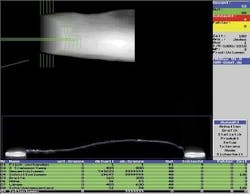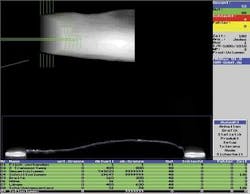Smart camera system slices salmon
Structured-light vision techniques simplify the process of triangulating the position of points in space. A beam of light with known geometry is projected onto a scene and a camera observes the shape of those objects that can then be reconstructed. This is especially useful in reverse-engineering three-dimensional parts, where objects must be digitized to high degrees of accuracy.
At Vision 2004 (Stuttgart, Germany), however, this technique was put to new use, determining with precision how fish-slicing machines could be optimized to make the best cut of filleted fish before vacuum-packing. The system, shown by engineers of IBN Ingenieurbüro Bernd Neumann (IBN; Mülheim/Ruhr, Germany; www.ibn-gmbh.de), was built under contract for the GEBA Röscherwerke (Bersenbrück, Germany; www.roescher.de) HS-240 and shown at last year’s International Boston Seafood Show in Boston, MA.
“To process the more than 120 fillets per hour required by the machine,” says Bernd Neumann, managing director, “the system was required to image individual salmon fillets, calculate their volume and weight, and then determine the slicing angle of the cutting system so that complete 200-g packages could be optimally produced.” Neumann and his colleagues illuminated the fillets as they traveled along a 200-mm-wide conveyor path using a structured laser light from StockerYale (Salem, NH, USA; www.stockeryale.com).
“To provide information to the slicing machine, it is first necessary to calculate the height plot of the fish as it travels along this conveyor,” says Neumann. To do this, a VC-20XX smart vision camera from Vision Components (Ettlingen, Germany; www.vision-components.com) was mounted at 45° to the conveyor belt to capture the laser light at 5-mm intervals. After data are collected, smooth height data are interpolated from these height data points to provide a smooth contour of the height of the fish.
Because the system is first calibrated with an object of known height, the height data can then be translated into real-world coordinates and the volume of this fish calculated. And, because the weight/volume of the fish is already known, the cutting-blade angle of the slicing machine can be calculated to optimally produce the correct number of slices with the correct weight per slice.
“Because the VC-20XX camera incorporates a Texas Instruments (Dallas, TX, USA; www.ti.com) on-board C3020C6211,” says Neumann, “it was possible to write all these image-processing routines using Code Composer and embed them in the smart camera.” Once written, the digital and serial I/O of the camera allowed commands to be sent directly to the PLC that controls the fish slicer. Thus, no camera/frame grabber/PC combination was required, which dramatically lowered the cost of implementing the machine-vision part of the system.
Neumann expects that other food-packaging manufacturers will take advantage of this technology. “We have already seen interest from meat- and dairy-packaging companies,” he says.

